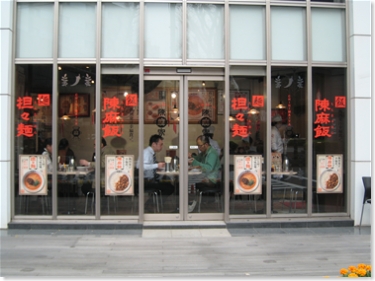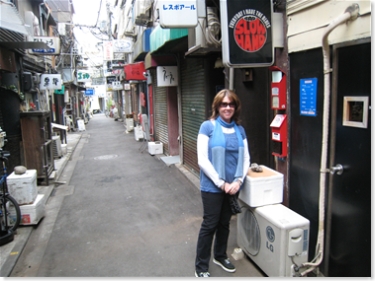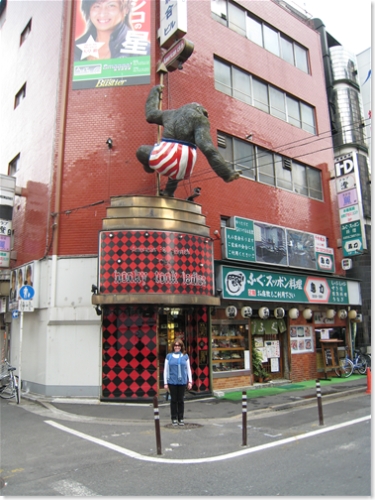Here we are, safe and sound in Tokyo. We arrived on Friday evening, which was actually late Thursday night for all you Americans out there. The flight was uneventful and not altogether unpleasant, though as with any long plane trip I generally feel like killing myself (anything to put me out of my misery) about halfway through. This one was no different. Three things to note, however:
1) While we were taxiing, the music playing was the "Theme from Taxi." Not sure if it was intentional, but I thought it an amusing touch.
2) There was a camera during taxi, take off, and landing that showed the pilot’s view. I’d never seen that before, and being a nervous flyer, I’m not sure I need to see it again.
3) The airline food was beautiful (Japan Airlines).

When we arrived at our hotel on Friday evening, it was about 7pm Tokyo time, which was about 1am pst. Both of us were exhausted, so we tumbled into bed, understanding we’d be up very early the next morning. We figured it was okay since we’d planned to visit the Tsukiji Central Fish Market, hoping to see the tuna auction around 6am.
We set off around 5am and had a pleasant walk through the streets of Ginza on our way to the market. It was nice to get a look at Tokyo before the bustling crowds ensued.

I actually didn’t realize just how pleasant it was until we toured Shinjuku later in the day, but more on that later.
Upon arriving at Tsukiji Fish Market, we saw workers everywhere, zipping quickly here and there on little carts carrying all manner of sea creatures. Mick had warned me about the carts–boy, he wasn’t kidding. They were everywhere, and the drivers didn’t seem too bothered by the idea of hitting a happless tourist.

It was not immediately evident where we were meant to go, but a nice Japanese man working the market noticed our confusion and laughingly pointed where we were supposed to go. Once in the auction area, I felt happy to see many tourists just like us. There is a passage way where visitors can watch the auction, and it was packed with a variety of faces, both western and asian.

On the floors of the auction rooms, huge frozen tunas were lined up for close examination by potential buyers. Sure, there were a lot of fish, but what was really amazing to me is that this happens every day. Here is where the wholesalers purchase the tuna from the fishermen, then it’s moved to the actual market where it’s then sold to restaurants and retailers. To put it in some kind of perspective, about 2246 tons of fish worth over US$15.5 million are sold here daily.

The actual market itself was, to me, a whole lot more interesting than the tuna auction.

Multiply what you see in this picture by, oh, I don’t know–1000, maybe more. The atmosphere was less chaotic than the auction, but no less intense.

Mick and I had no idea what most of what we saw was, but we were reasonabley sure it was all edible and that with any luck, we’d get to try it in some Japanase restaurant or another.


As is the tradition, Mick and I finished our visit to the market with a sushi breakfast at one of the nearby sushi places. There were several to choose from, and most had long lines. The one we chose was called Ya Ma Za Ki, which featured picture menus in English and Japanese and frankly was no different ordering wise than being in the US. Our chef, who was very nice, spoke English, though he appreciated my attempts to order in Japanese.

The sushi was delicious–much more flavorful than I’ve had in most places in LA and the texture of the fish was lovely.
The walk back to the hotel was punctuated by a cursory visit to a McDonalds:

Various other sites included the Wako building, which I hope to blog about later and Kabuki-za, a famed Kabuki theater.

An afternoon in Shijuku
After a brief nap, Mick and I headed out by taxi to another area of the city called Shinjuku. We’d pondered on whether or not to take the train, but I think both of us were feeling a little tired and unsure of ourselves. With taxis right outside the hotel it seemed a lot easier just to take that than braving the scary world of the subway.
Our first stop in Shinjuku was the Japanese Sword Museum. It was a small, out of the way museum (seemed like it was in a back alley) that had swords on display from about the 13c to the 19c. Unless you are interested in swords, I wouldn’t make the trip, but Mick is very interested in them and has done a lot of research into them. A few years back I bought him a modern Japanese katana made in the traditional way, so both of us were interested in seeing this museum.
Next we wanted to go to the New York Bar in the Park Hyatt Tokyo (of Lost in Translation fame) but were disappointed to find it didn’t open until 5pm. We settled for beers in their lounge:

As you can see, I look like I needed some form of alcoholic beverage at that moment.
The Park Hyatt offered views of the city that kind of put it in perspective a little. Tokyo, at least to my untrained eye, is a bit of a mish-mash. That seemed apparent as we gazed from one side of the Park Hyatt, which was high rises:

To the other side, with reminded me of a kind of permanent shanty town:

I don’t mean that to be negative, just that the contrast was interesting to me.
Next we made our way to Isetan, which is a high end department store on Meji-Dori and Shinjuku-dori. On the way, we ducked into a pachinko parlour, something that I was looking forward to seeing since as a kid we had a pachinko machine. Pachinko is technically illegal in Japan, but they get around the law by making you purchase tokens for the machines. Payouts are in the form of little metal balls which you exchange for "prizes," which you can then "sell" at another window for cash. I really wanted to play, but everything was in Japanese and it was too loud to communicate with the attendant so we ran out like scared children.
Isetan reminded me of a less luxurious version of Selfridges in London. By "less luxurious" I mean that the building itself was rather plain and utilitarian, however the brands sold and the prices, are not. Every high end designer I’d ever heard of and a whole lot I hadn’t were represented here. As much as I sometimes wish I was, I’m just not the designer clothing type and I can’t justify spending so much money on something just for a label (sure, I know they’re quality goods, but you know what I mean). I went to the Paul Smith department and almost bought a bag or a rain hat, just to say I did, but I resisted the temptation. Now I wish I hadn’t, because it is raining dreadfully here at the moment and I wish I had that Paul Smith hat (or any hat, actually). Isetan was interesting, but not being hardcore shoppers, Mick and I explored a couple of floors and left.
Our next stop was another department store called Takashimaya Times Square because Mick wanted to meet with an American artist named Rodney Allen Greenblatt who was having an exhibit there (they are going to be collaborating on Mick’s next article for Game Developer Magazine). Not being sure where Rodney was in the store (14 floors) we explored this one in much more detail than we had Isetan.

Floor after floor of almost anything you can imagine was being sold here and a whole lot of other things you could never imagine even existed. We had a lovely lunch of tempura on the 14th floor, then resumed our search for Rodney. When we finally found him, there was a long line of Japanese waiting to talk ot him and get things signed, as well as a crew filming him. Mick decided to just email him later.
I wish we would’ve taken more pictures in Shinjuku because frankly, it defies description. I think perhaps we were scared into submission but the crowds, noise, and flashing lights. We did, however, decide to brave the train home and a nice Canadian named Damien noticed we looked confused and he helped us buy tickets and rode part of the way home with us.
We ended the day in the tradition of weary travelers in Tokyo:

In bed, in our kimono robes, and with a bottle of sake from the mini bar.
The adventure will continue tomorrow…

 The cherry blossoms aren’t just a tourist attraction–Tokyoites love them too. And what’s not to love? I feel so lucky that we got to see them.
The cherry blossoms aren’t just a tourist attraction–Tokyoites love them too. And what’s not to love? I feel so lucky that we got to see them. The park was absolutely gorgeous. Everywhere you looked there were cherry blossoms and people. I did see a number of gaijin in the park, but unlike us, they seemed to be gaijin living in Tokyo.
The park was absolutely gorgeous. Everywhere you looked there were cherry blossoms and people. I did see a number of gaijin in the park, but unlike us, they seemed to be gaijin living in Tokyo.





 It ended up being one of the best meals I had in Japan. My noodles were in a very spicy broth and they were simply delicious.
It ended up being one of the best meals I had in Japan. My noodles were in a very spicy broth and they were simply delicious. Next we made our way to a seedy area of Shinjuku called Kabukicho. It’s billed as a red-light district, but during the day it doesn’t seem to have much going on.
Next we made our way to a seedy area of Shinjuku called Kabukicho. It’s billed as a red-light district, but during the day it doesn’t seem to have much going on. 
 Almost as soon as we walked into Kabukicho I wanted to leave. Like most of Tokyo, I didn’t feel unsafe, but I did feel uncomfortable. We made our way back to Shinjuku.
Almost as soon as we walked into Kabukicho I wanted to leave. Like most of Tokyo, I didn’t feel unsafe, but I did feel uncomfortable. We made our way back to Shinjuku.























































































































































